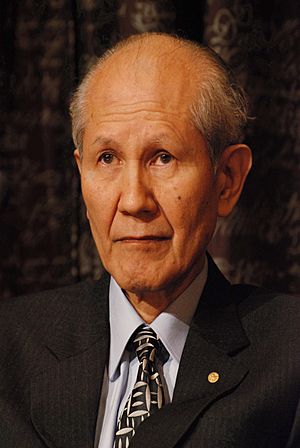Osamu Shimomura facts for kids
Quick facts for kids
下村 脩
Shimomura Osamu |
|
|---|---|

Shimomura in 2008
|
|
| Born | August 27, 1928 Fukuchiyama, Empire of Japan
|
| Died | October 19, 2018 (aged 90) |
| Nationality | Japanese |
| Alma mater | Nagasaki University Nagoya University |
| Awards | Asahi Prize (2006) Nobel Prize in Chemistry (2008) Golden Goose Award (2012) |
| Scientific career | |
| Fields | Organic chemistry |
| Institutions | Princeton University Boston University School of Medicine Marine Biological Laboratory |
| Thesis | 海ホタルルシフェリンの構造 (1960) |
| Doctoral advisor | Yoshimasa Hirata |
Osamu Shimomura (下村 脩, Shimomura Osamu, August 27, 1928 – October 19, 2018) was a Japanese organic chemist and marine biologist. He was a Professor Emeritus at the Marine Biological Laboratory (MBL) in Woods Hole, Massachusetts. He also taught at Boston University School of Medicine.
In 2008, he won the Nobel Prize in Chemistry. He shared this award with two American scientists. They were Martin Chalfie and Roger Tsien. They won for finding and developing the green fluorescent protein (GFP).
Contents
Early Life and Education

Osamu Shimomura was born in Fukuchiyama, Kyoto in 1928. He grew up in Manchukuo (China) and Osaka, Japan. His father was an officer in the Japanese Army. Later, his family moved to Isahaya, Nagasaki. This town was about 25 kilometers from where the atomic bomb exploded in August 1945.
As a 16-year-old, he heard the bomber plane Bockscar. Then, the atomic bomb exploded. The bright flash blinded him for about 30 seconds. He was later covered by "black rain" from the bomb. Despite these challenges, he worked hard to get an education.
After the war, it was hard to find good schools in Japan. Shimomura enrolled in the College of Pharmaceutical Sciences at Nagasaki Medical College. This school is now Nagasaki University. The original campus was destroyed by the bomb. So, the pharmacy school moved to a temporary campus near his home. This was a lucky chance that led him to his future career. He earned his first degree in pharmacy in 1951. He then worked as a lab assistant until 1955.
Discovering Bioluminescence
Shimomura's teacher in Nagasaki helped him get a job in 1956. He became an assistant to Professor Yoshimasa Hirata at Nagoya University. While working there, he earned two more degrees. He got a Master of Science (MS) in organic chemistry in 1958. He also earned his Doctor of Philosophy (Ph.D.) in organic chemistry in 1960.
At Nagoya, Professor Hirata gave Shimomura a difficult task. He wanted to know why a type of crustacean called a "sea-firefly" (Vargula hilgendorfii) glowed when wet. Shimomura successfully found the protein that caused this glow. He published his first findings in a science paper. This paper caught the eye of Professor Frank Johnson at Princeton University. Johnson invited Shimomura to work with him in the United States in 1960.
Research on Green Fluorescent Protein (GFP)
At Princeton University, Shimomura worked with Professor Johnson. They studied a glowing jellyfish called Aequorea victoria. They collected these jellyfish during many summers at the Friday Harbor Laboratories. In 1962, their hard work paid off. They discovered two important proteins in the jellyfish: aequorin and green fluorescent protein (GFP).
This discovery of GFP was very important for science. It allows scientists to see inside living cells and organisms. This helps them study diseases and understand how life works. For this amazing work, Osamu Shimomura received a third of the Nobel Prize in Chemistry in 2008.
Family Life
Osamu Shimomura's wife, Akemi, was also an organic chemist. They met at Nagasaki University. She helped him with his research. Their son, Tsutomu Shimomura, is an expert in computer security. He was involved in catching a famous computer hacker, Kevin Mitnick. Their daughter, Sachi Shimomura, teaches English at Virginia Commonwealth University. She has also written books.
Awards and Recognition
Osamu Shimomura received many awards for his scientific work. These include:
- 2004 – Pearse Prize, Royal Microscopical Society
- 2005 – Emile Chamot Award
- 2006 – Asahi Prize
- 2008 – Nobel Prize in Chemistry
- 2008 – Order of Culture (a high honor in Japan)
- 2008 – Person of Cultural Merit
- 2012 – Golden Goose Award
- 2013 – Member of the United States National Academy of Sciences
- 2018 – Junior third rank (given after his death)
See also
 In Spanish: Osamu Shimomura para niños
In Spanish: Osamu Shimomura para niños
- List of Japanese Nobel laureates
- Kamo Aquarium
Sources
- [[Category:Nobel Prize in {{{1}}} winners]] including the Nobel lecture Discovery of Green Fluorescent Protein, GFP

